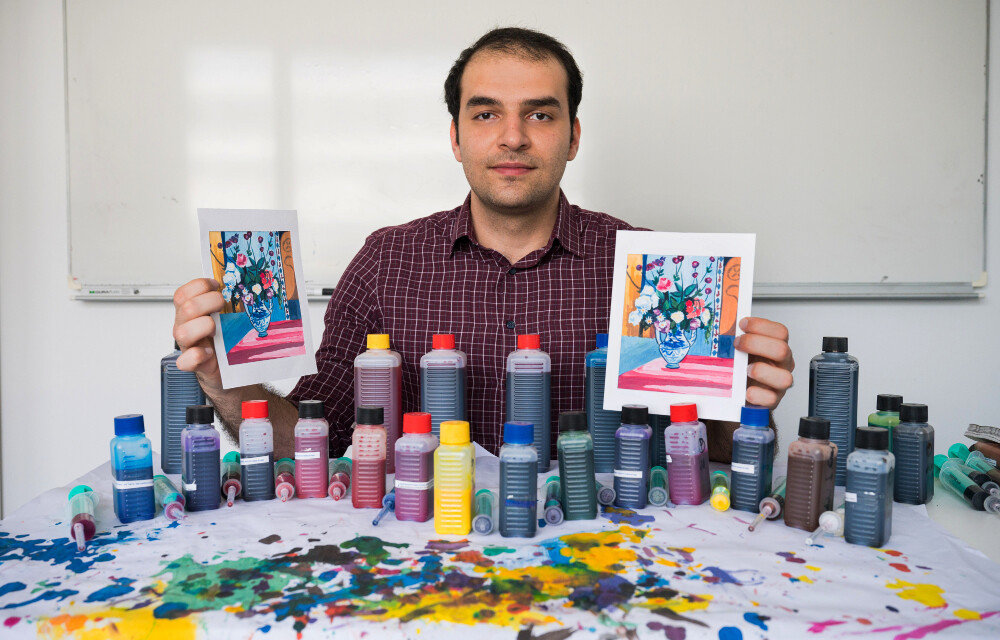Paintings from the printer – Saarbrücken Master’s Student improves process for printing fine art products

Navid Ansari with the original and the print of the painting "Flower" by Azadeh Asadi ©Oliver Dietze
View all images
A computer science master’s student at Saarland University shows in his thesis how to produce high-quality fine art printings using commonly available inkjet printers. To achieve this, he has developed an algorithm that can analyze and reproduce a painting down to its optical fingerprint.
In his master’s thesis, Saarland University computer science student Navid Ansari focused on spectral reproduction. “Spectral reproduction is a process that aims to produce an exact spectral copy of an input that has the same optical properties as the original,” says Navid Ansari. In his research project he used the approach to reproduce watercolor paintings. “Compared to a mere color reproduction, the spectral reproduction of a painting looks exactly the same as the original under all possible illuminations,” adds Navid Ansari. This makes the process especially interesting for application scenarios like fine art reproduction in museums or by the artists.
The novel approach first determines representative points in the template. These so-called ‘core-sets’ cover the entire color spectrum of the prospective print. Based on these core-sets, mixed integer optimization calculates which inks will achieve the best print results. Different from current approaches, the novel algorithm does not refer to the reflectance values of the colors, but instead uses their absorption values – as in how much light a surface covered with the color absorbs. “Through this inversion we solve a major problem of spectral reproduction, because it reduces the optimization complexity dramatically. This makes our approach the first to be tractable, also for larger ink libraries,” says Navid Ansari.
For this, the researchers had to optimize their input materials: “Commonly available inkjet printers use factory made ink-cartridges which have fixed optical properties. With such limited available materials, optimal spectral reproduction is not possible. This is why we first had to expand our selection of inks,“ says Navid Ansari. The scientists developed an ink-library of 43 different inks which were used for the printings on a commonly available inkjet printer. The paintings for their research were provided by artist Azadeh Asadi.
Navid Ansari wrote his master’s thesis in the research group “Computation, Appearance and Manufacturing” at the Saarbrücken Max-Planck-Institute for Informatics at Saarland Informatics Campus. The group led by Vahid Babaei PhD, is investigating how to leverage the full potential of modern manufacturing methods, such as 3D printing or laser marking. “We explore the possibilities of new devices and develop the algorithms to use them to the fullest,” says Vahid Babaei about the group’s work. Building on Navid Ansari’s research, the group’s future projects will include how the concepts behind the novel optimization algorithm can improve material selection in other contexts, such as 3D printing.
Original Publication:
The paper titled ‘Mixed Integer Ink Selection for Spectral Reproduction’ was published at SIGGRAPH Asia 2020. On the part of the Max-Planck-Institute for Informatics, Navid Ansari, Vahid Babaei and Professor Hans-Peter Seidel were involved. In addition, Omid Alizadeh-Mousavi from the Swiss company Deepsys SA also contributed to the project. A PDF-version of the paper is available under: https://doi.org/10.1145/3414685.3417761
More Information:
http://cam.mpi-inf.mpg.de/?view=home
https://saarland-informatics-campus.de/
Questions can be directed at (English only):
Vahid Babaei, PhD
vbabaei@mpi-inf.mpg.de
+49 681 302 70761
Navid Ansari, MSc
nansari@mpi-inf.mpg.de
Background Saarland Informatics Campus:
800 scientists and about 2100 students from more than 80 nations make the Saarland Informatics Campus (SIC) one of the leading locations for computer science in Germany and Europe. Five world-renowned research institutes, namely the German Research Center for Artificial Intelligence (DFKI), the Max Planck Institute for Computer Science, the Max Planck Institute for Software Systems, the Center for Bioinformatics and the Cluster for “Multimodal Computing and Interaction” as well as Saarland University with three departments and 21 degree programs cover the entire spectrum of computer science.
Editor:
Philipp Zapf-Schramm
Competence Center Computer Science
Saarland Informatics Campus
Phone: +49 681 302-70741
E-Mail: pzapf@mmci.uni-saarland.de
Press photos for download for use free of charge in connection with this press release:
Die Öffentlichkeitsarbeit am Saarland Informatics Campus wird unterstützt durch das Kompetenzzentrum Informatik Saarland, gefördert aus Mitteln des Europäischen Fonds für regionale Entwicklung (EFRE) und Mitteln der Staatskanzlei Saarland.



